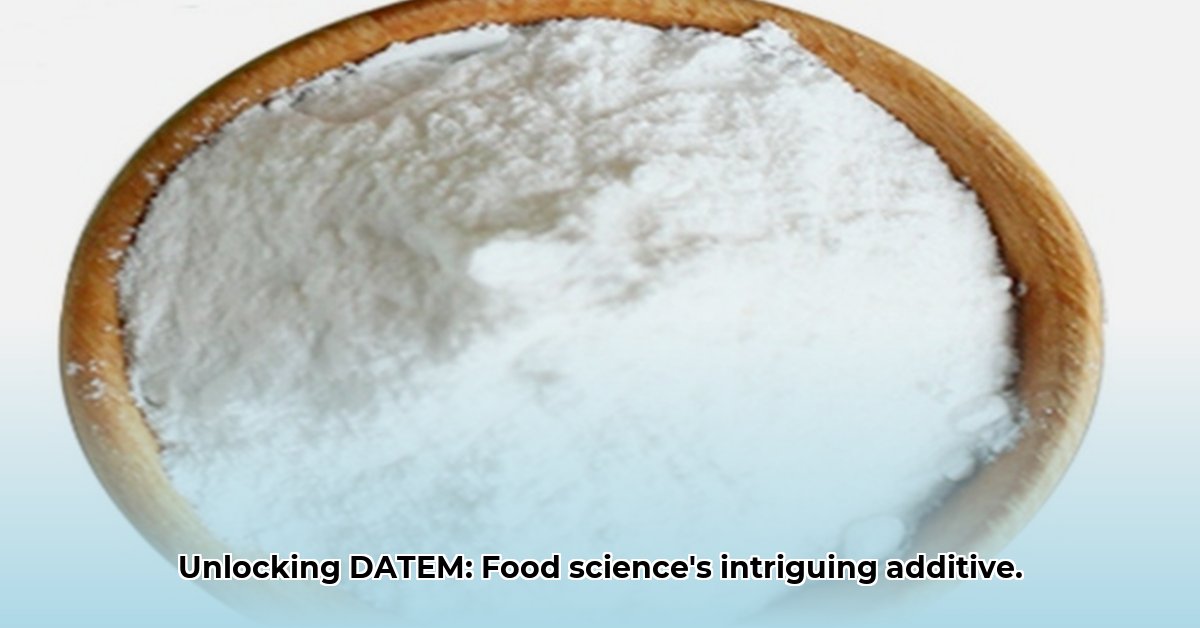DATEM, or Diacetyl Tartaric Acid Esters of Monoglycerides, is a common ingredient found in numerous food products. This article offers a comprehensive exploration of DATEM, covering its composition, production, applications in baking and other food items, safety considerations, and comparisons to alternative ingredients. It serves as a comprehensive resource for understanding and confidently utilizing DATEM in food creations.
Understanding DATEM: Composition and Creation
DATEM, an acronym for Diacetyl Tartaric Acid Esters of Monoglycerides, acts as a food additive, enhancing the qualities of products such as bread and ice cream. It’s a synthetic emulsifier, allowing oily and watery ingredients to blend seamlessly.
Decoding DATEM’s Composition and Production Methods
DATEM is produced in a lab setting by combining acetic acid (found in vinegar), tartaric acid (a natural acid present in grapes), glycerol (a type of alcohol found in fats), and fatty acids (typically extracted from plant oils like soybean, canola, or palm oil). The production process involves a chemical reaction called esterification, which transforms these ingredients into DATEM. The resulting product is often a white to creamy-colored powder with a slightly fatty odor.
The exact process can vary, but generally involves the reaction of diacetyl tartaric anhydride with mono- and diglycerides. These mono- and diglycerides are themselves derived from the esterification of glycerol with fatty acids. The proportions of each component can influence the final properties of the DATEM.
The particle size of DATEM, along with any added anti-caking agents (like calcium carbonate, tricalcium phosphate, or trisodium phosphate), can also affect its performance in food applications.
Exploring DATEM’s Functionality and Food Applications
DATEM’s primary function is to enhance the texture and quality of baked goods. It achieves this by strengthening the gluten network in bread dough, leading to a lighter, airier crumb and extended shelf life. DATEM interacts with gluten proteins, promoting protein aggregation and stabilizing the foam structure within the dough.
Beyond baked goods, DATEM is found in other foods such as:
- Coffee creamers
- Ice cream
- Salad dressings
- Soups
- Beverage whiteners
- Vegetable protein drinks
- Emulsified sauces
- Canned coffee and tea
In these applications, it contributes to creamy textures and overall stability. The amount of DATEM required depends on the specific recipe and desired outcome. It often works synergistically with other emulsifiers, creating unique textures that food scientists and manufacturers are constantly exploring. It is typically used at levels of 0.2-0.6% based on flour weight.
DATEM: Safety, Regulations, and Continuous Research Initiatives
Leading regulatory bodies, including the U.S. Food and Drug Administration (FDA) and the European Food Safety Authority (EFSA), classify DATEM as generally recognized as safe (GRAS) for consumption at approved levels. The FDA permits its use as an emulsifier, emulsifier salt, and flavoring agent/adjuvant in various food categories. The Joint FAO/WHO Expert Committee on Food Additives (JECFA) has also established an Acceptable Daily Intake (ADI) of 0-50 mg/kg body weight for DATEM.
However, a 2002 study on rats indicated potential long-term health risks, showing that “heart fibrosis and adrenal overgrowth” were found in the rats that were exposed to DATEM which warrants ongoing investigation. While the amounts used in food are generally low, continued research into potential long-term effects and interactions within the body is crucial. Scientists are actively assessing the risks and benefits, considering the limitations of previous studies, the levels of DATEM used in food, and the ongoing research.
Stakeholder Involvement and Future Actions Regarding DATEM
Addressing concerns about DATEM requires collaboration among various stakeholders:
- Food Manufacturers: Should prioritize transparent sourcing, consider funding independent safety tests, and optimize DATEM formulations for both effectiveness and sustainability.
- Regulatory Agencies: Should update regulations based on emerging scientific evidence, provide funding for thorough human studies on DATEM, and ensure clear labeling requirements.
- Consumers: Should look for ingredient lists that clearly specify DATEM content, advocate for transparent labeling practices, and stay informed about the latest scientific findings.
- Health Professionals & Researchers: Should disseminate findings openly to the public and encourage further research into DATEM’s long-term effects on human health, including potential impacts on the gut microbiome.
In conclusion, DATEM is a widely used food ingredient crucial for food processing. Although deemed safe by regulatory agencies, research continues to explore its long-term impacts. Continued transparency and ongoing research will ensure the responsible use of DATEM and inform consumers and producers alike. As additional evidence emerges, the future of DATEM’s role in the food supply chain will likely evolve.
Examining DATEM’s Impact on Gut Microbiota and Long-Term Health
How does DATEM, or diacetyl tartaric acid esters of mono- and diglycerides, impact gut microbiota and long-term health? This remains a complex question due to the limited direct research available. As an emulsifier commonly used in baked goods, DATEM’s primary role is to improve texture and prevent ingredient separation. Understanding how food additives might affect this complex ecosystem is essential.
DATEM’s Role in Food and Digestion Dynamics
DATEM is not directly digested as a nutrient source. Instead, it acts as a structural component in food. By altering food texture, it could indirectly influence bowel movements or the rate of nutrient absorption. Changes in the transit time of food through the gut might also alter gut microbiome composition. The need for further research is clear.
Understanding the Gut Microbiome’s Significance
The gut microbiome supports essential body functions, from digestion to immune response. Changes to its composition can significantly impact health. It’s plausible that the way DATEM alters food texture could indirectly influence bowel movements or the rate of nutrient absorption. Understanding how food additives might affect this complex ecosystem is critical and requires dedicated research focusing on the interactions between DATEM and specific gut bacterial species.
Addressing Uncertainties and Research Deficits
Currently, there’s a lack of scientific evidence addressing how DATEM specifically impacts gut microbiota and long-term health. To fully understand DATEM’s impact, we need long-term studies that specifically examine its effects. Further research is essential to determine if any observed changes in gut microbiota are truly caused by DATEM or are influenced by other factors in a person’s overall diet.
Future Research Initiatives on DATEM
Future research on DATEM should focus on experiments testing its effect on different gut bacteria and longitudinal studies tracking gut health in individuals with varying DATEM consumption. This research should consider factors such as dosage, individual variability in gut microbiome composition, and potential interactions with other dietary components. This will help us answer the central question: How does DATEM impact gut microbiota and long-term health?
Key Insights:
- DATEM is an emulsifier and not a nutrient.
- The direct impact on gut microbiota is largely unknown.
- More short-term and long-term research is needed.
- Indirect effects through altered food digestion are possible but require further study.
- The complexity of the gut microbiome makes isolating DATEM’s effects challenging.
Diverse Applications of DATEM in Food Manufacturing
DATEM (E472e) functions as an emulsifier to improve texture and extend shelf life in various products. While generally considered safe, ongoing research is needed to understand its long-term health effects. DATEM’s effectiveness varies greatly based on formulation, product type, and ingredient quality.
Key Insights:
- DATEM (E472e) blends oil and water.
- Manufacturers should prioritize optimizing DATEM formulations and sustainable sourcing.
- Consumers should support companies committed to ethical practices and transparent labeling.
The Function of DATEM as an Emulsifier
DATEM (E472e) enhances the texture and structure of baked goods by strengthening gluten networks in dough, leading to a better rise and longer-lasting freshness. DATEM’s impact extends beyond simple mixing. It helps to stabilize the dough, improve gas retention, and create a more uniform crumb structure.
Examining DATEM’s Diverse Applications in Food Production
DATEM has extensive applications, ranging from the perfect rise of bread to the creamy texture of ice cream. DATEM is integrated into:
- Baked Goods: Impacts dough structure and gas retention in pastries, breads, rolls, cakes, rusks, and biscuits.
- Dairy Products: Utilized to enhance texture and stability in creamers, ice cream, and dairy product analogs.
- Spreads: Plays a role in salad dressings and margarine for emulsification and a creamy feel.
- Meat Products: Enhances texture and moisture retention in processed meats.
- Snacks: Enhances texture and improves shelf life in snack foods.
- Beverages: Used in beverage whiteners, vegetable protein drinks, and canned coffee/tea.
Safety and Regulatory Status: Concerns
DATEM is recognized as safe (GRAS) in the U.S. and approved under E472e in the EU and many other countries. However, the 2002 rat study raised concerns about long-term
- Water Wheel Electric Generator Provides Free Home Electricity - December 15, 2025
- Choosing the Right Portable Hydro Turbine for Your Needs - December 14, 2025
- Best Portable Hydro Generators for Off-Grid and Outdoor Power - December 13, 2025
















